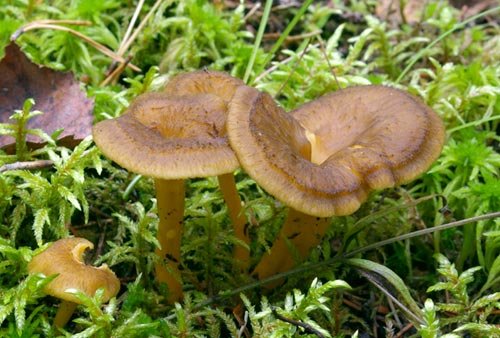Chanterelle tubular (Craterellus tubaeformis)
- Division: Basidiomycota (Basidiomycetes)
- Subdivision: Agaricomycotina (Agaricomycetes)
- Class: Agaricomycetes (Agaricomycetes)
- Subclass: Incertae sedis (of uncertain position)
- Order: Cantharellales (Chanterella (Cantarella))
- Family: Cantharellaceae (Cantharellae)
- Genus: Craterellus (Craterellus)
- Type: Craterellus tubaeformis (Tubular chanterelle)

Chanterelle tubular (lat. Chanterelle tubaeformis) is a mushroom of the chanterelle family (Cantharellaceae).
Hat:
Medium-sized, even or convex in young mushrooms, acquires a more or less funnel-shaped shape with age, elongates, which gives the entire fungus a certain tubular shape; diameter – 1-4 cm, in rare cases up to 6 cm. The edges of the cap are strongly tucked up, the surface is slightly irregular, covered with inconspicuous fibers, slightly darker than the dull yellowish-brown surface. The flesh of the cap is relatively thin, elastic, with a pleasant mushroom taste and smell.
Records:
The hymenophore of the tubular chanterelle is a “false plate”, looking like a branched network of vein-like folds descending from the inside of the cap to the stem. Color – light gray, discreet.
Spore powder:
Light, grayish or yellowish.
Leg:
Height 3-6 cm, thickness 0,3-0,8 cm, cylindrical, smoothly turning into a hat, yellowish or light brown, hollow.
Spread:
The period of abundant fruiting begins at the end of August, and continues until the end of October. This fungus prefers to live in mixed and coniferous forests, in large groups (colonies). Feels good on acidic soils in the forest.
Chanterelle tubular comes across in our area not so often. What is the reason for this, in its general inconspicuousness, or is Cantharellus tubaeformis really becoming a rarity, it is difficult to say. In theory, the tubular chanterelle forms a hymenophore with coniferous trees (simply, spruce) in damp mossy forests, where it bears fruit in large groups in September and early October.
Similar species:
They also note the yellowing chanterelle (Cantharellus lutescens), which, unlike the tubular chanterelle, is devoid of even false plates, shining with an almost smooth hymenophore. It is even more difficult to confuse the tubular chanterelle with the rest of the mushrooms.
- Cantharellus cinereus is an edible gray chanterelle characterized by a hollow fruiting body, grey-black color and lack of ribs at the bottom.
- Chanterelle ordinary. It is a close relative of funnel-shaped chanterelles, but differs in that it has a longer fruiting period (unlike the funnel-shaped chanterelle, which abundant fruiting occurs only in autumn).
Edibility:
It is equated to the real chanterelle (Cantharellus cibarius), although the gastronome is unlikely to bring so much joy, and the aesthete will not soon get bored to the same extent. Like all chanterelles, it is used mainly fresh, does not require preparatory procedures such as boiling, and, according to writers, is not full of worms. It has yellowish flesh, inexpressive taste when raw. The smell of raw funnel-shaped chanterelles is also inexpressive. Can be marinated, fried and boiled.









